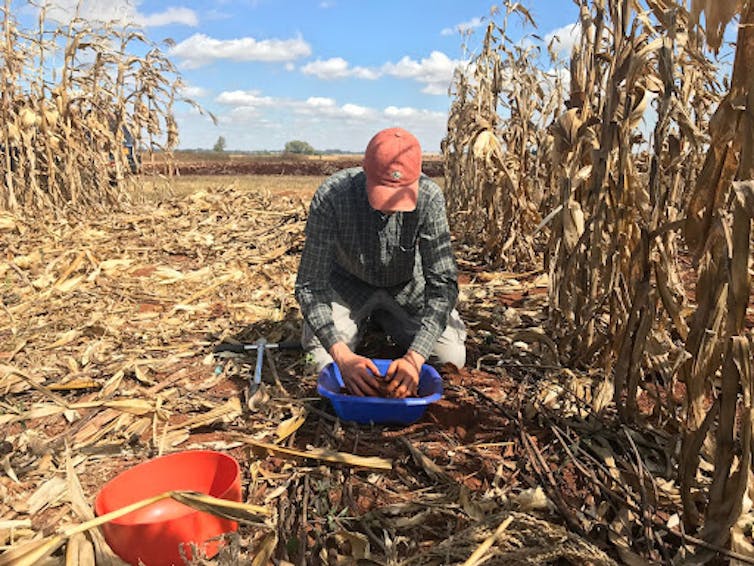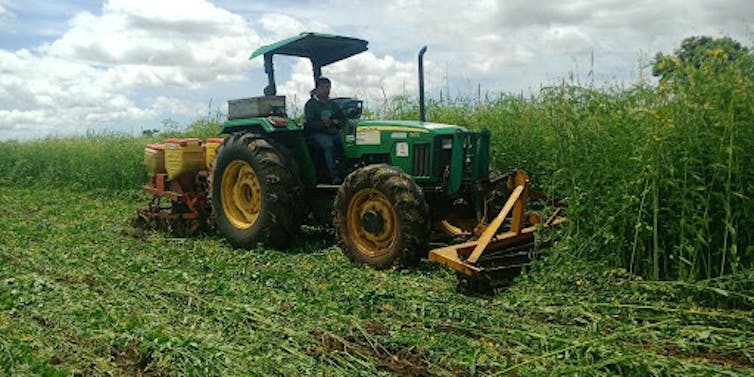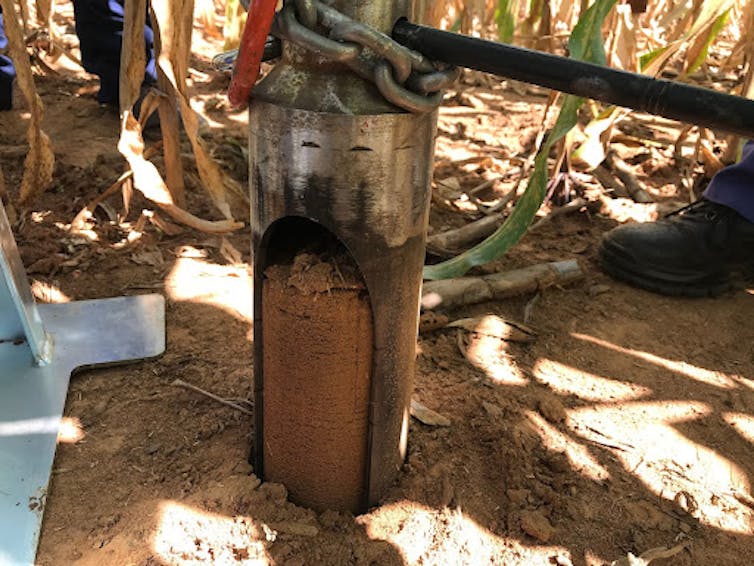Carbon sequestration in the soil: what agriculture can do
It's there, beneath our feet. In our daily lives, we hardly look at it, and yet it is nothing less than the largest carbon stock in the earth's ecosystems. In fact, it's not the forests or the atmosphere that hold the prize, but the soil. Around 2,400 billion tonnes of carbon are found in the first two metres of soil, three times more than in the atmosphere.
Rémi Cardinael, CIRAD ; Armwell Shumba, University of Zimbabwe and Vira Leng, University of Montpellier

At a time of climate disruption and the absolute need to reduce greenhouse gas emissions, the impressive capacity of soils to store carbon is truly astonishing. While soils alone will obviously not be able to drastically reduce the concentrations of greenhouse gases in the atmosphere that are responsible for global warming, they can nevertheless play a substantial role, not only by preserving large stocks of underground carbon, but also by restoring degraded land, notably through certain agricultural practices, which enable more carbon to be trapped underground, here's how.
How carbon enters the soil
It all starts with photosynthesis: during photosynthesis, plants fix atmospheric carbon dioxide (CO2) within chloroplasts, small cell organelles rich in chlorophyll. Thanks to solar energy, theCO2 is combined with water molecules (H20) to produce carbohydrates (carbon-rich molecules) and oxygen (O2). Part of this carbon captured by the plant is transferred directly to the soil via the plant's roots, both through root exudation and the renewal of fine roots.
Carbon can also enter soils when dead plant leaves fall, or when crop residues are left on the field. Once fallen, these carbon-rich dead leaves cover the soil, decompose, are ingested by bacteria, fungi or earthworms and eventually transform into soil organic matter. Animals can also accelerate the process of transferring carbon into the soil, for example, mushroom termites, which transport plant residues into their termite mounds, where symbiosis with fungi makes them more readily assimilated.
Some regions and ecosystems have very large soil carbon stocks. This is the case, for example, in boreal regions, where huge stocks are preserved in permafrost, but are now threatened by global warming. In tropical regions, the high productivity of ecosystems, particularly forests, and very deep soils, also explain the large stocks observed.
The main challenge for all these carbon-rich ecosystems, such as forests, wetlands, mangroves and permanent grasslands, is to maintain these stocks rather than increase them, as this carbon is considered irrecoverable on a human scale. This means halting deforestation and the conversion of ecosystems to farmland. On average, 25% of soil carbon is lost when forests or wetlands are converted to cropland, sometimes more. On farmland, certain practices enable more carbon to be sequestered in the soil. Generalizing their use is one of the objectives of the "4 for 1000" initiative launched at COP21.
What agricultural practices increase soil carbon stocks?
A number of practices can be used to increase carbon stocks in agricultural soils, such as agroforestry, intermediate cover crops and organic soil improvers. Among the solutions often put forward, three come up regularly. The first is non-tillage or reduced tillage. This technique consists in sowing crops without ploughing or tilling the entire field beforehand. This practice reduces soil erosion, slows the decomposition of organic matter through reduced soil oxygenation, and preserves soil biodiversity (notably earthworms).
The second practice promoted is that of permanent soil cover, either with mulches made from crop residues left on the field, or with living plant cover between different crops. This type of soil cover protects against erosion, particularly water erosion, and helps to fix carbon, while benefiting the soil's fauna (bacteria, fungi, earthworms, etc.).

The third technique promoted is crop diversification, either in rotation or in association. This diversification not only limits the development of plant pests and diseases, but also increases the productivity of cultivated plots, notably through the preceding effects of crops. For example, a legume (pea, bean, peanut, faba bean, alfalfa, etc.) in the rotation will fix nitrogen from the air and make it available in the soil for the following crop, thus promoting its growth. Better crop productivity means more carbon fixed on the plot, and therefore more carbon in the soil, notably via crop roots.

These three practices correspond to the three pillars of what is known as "conservation agriculture". These practices become truly effective in increasing soil carbon when combined. Practised alone, they sometimes have little or no impact. This is particularly true of no-till alone, which can have a positive effect on soil carbon in some contexts, but not in others. The scientific community was slow to realize this, as research initially focused on the first few centimetres of soil, which actually had a higher carbon content as a result of no-till.
But this was sometimes accompanied by a reduction in soil carbon in the deeper layers, compared with ploughed systems where soil carbon is homogenized over a depth of 20 or 30 cm. In some cases, therefore, no-till has mainly an effect on the redistribution of carbon in the soil profile, without necessarily leading to a net increase in the overall stock, which is necessary when we are interested in mitigating climate change. A recent synthesis of work carried out in sub-Saharan Africa suggests that only the combination of the three pillars of conservation agriculture can significantly increase soil carbon stocks, with reduced tillage alone being ineffective.
[More than 85,000 readers trust The Conversation newsletters to help them better understand the world's major issues. Subscribe today]
What are the results in Zimbabwe and Cambodia?
To fully understand the benefits of these three practices when combined, long-term experimentation is crucial. It takes an average of 5 to 10 years for a significant variation in soil carbon stock to be detected.
In Cambodia, CIRAD and the Cambodian Ministry of Agriculture began experimenting fourteen years ago with cassava-based systems, a crop covering almost 700,000 hectares in the country and mainly intended for export to produce flour for animal feed.
By combining no-till and direct seeding, permanent soil cover with plant cover, and crop rotation with maize, we have seen a significant increase in soil carbon, with carbon accumulation rates of around 0.7 to 0.8 tonnes of carbon per hectare per year down to a depth of 40 cm. The region's hot, humid climate enables permanent soil cover with highly productive plant cover crops including legumes (crotalaria, cowpea) and grasses (millet) between cassava and maize, on which maize is sown.
In so doing, carbon is fixed all year round by photosynthesis, and a very deep root system develops, increasing carbon stocks beyond the first soil strata. This additional carbon storage in the soil will continue until the system reaches a new equilibrium. This trial is intended to be maintained over time to estimate how many decades such a system can store carbon. Once equilibrium has been reached, the challenge will be to preserve these carbon stocks by maintaining good soil management practices. Good soil management implies long-term management, rather than management in fits and starts.

In Zimbabwe, in a totally different context, with a seven-month dry season and a five-month rainy season, we also wanted to measure the effectiveness of these coupled practices over the long term. To this end, we have at our disposal a trial set up by our colleagues at the International Maize and Wheat Improvement Center ten years ago in a low-input system with maize as the main crop. We were able to measure the soil carbon stocks of different practices, alone or in combination: fields with tillage, fields without tillage, with or without maize crop residue (mulch), and with or without rotation with cowpea, a legume.
Once again, the results show that no-tillage alone can't do much, and even induces a slight loss of soil carbon compared with tillage. This is explained on this site by the greater compaction of the soil when it is not worked, which makes it harder for roots to develop. In addition, rain penetrates less well and runs off the soil, causing water stress for the corn. As a result, maize does not develop as well in these systems, and roots contribute less carbon to the soil, resulting in a loss of soil carbon.
On the other hand, no-till fields mulched with maize crop residues from the previous season and crop rotation increased carbon stocks, although the effect was limited to the surface horizon. However, there was a net increase in carbon stock, as no deep carbon loss was observed.

What are the obstacles to the development of these practices?
While the results are promising, these practices are not always easy to implement. In Zimbabwe, for example, a major constraint is apparent. Farming systems are low-input mixed crop-livestock systems (little mineral fertilization, little or no mechanization). At harvest time, only the corn cobs are harvested, by hand, and the corn stalks are left standing in the field. These will serve as feed for the cattle during the dry season, when the cows come to graze directly in the fields, after having roamed in the forests and communal areas during the wet season.
There is therefore competition for the use of maize residues, either to feed livestock or to cover the soil. Some farmers install fences to prevent livestock from eating the residues during the dry season, which comes at a cost. Others harvest and store them high up, away from livestock, and bring in the mulch as the wet season approaches. This requires a great deal of organization, time and energy. In both cases, you also need to find an alternative source of feed for the livestock.
In these areas, as in others, the interest of these practices for farmers does not lie in soil carbon sequestration and its impact on climate change mitigation. These techniques are especially popular for their positive impact on soil fertility and the resulting crop productivity, by reducing the risk of erosion, improving nutrient availability and also enabling adaptation to climate change through, for example, improved water conservation. These benefits are crucial and often a priority for farmers in the Global South, who are among those most impacted by climate change.
This article is part of a project involving The Conversation France and AFP audio. It received financial support from the European Journalism Centre, as part of the "Solutions Journalism Accelerator" program supported by the Bill & Melinda Gates Foundation. AFP and The Conversation France retained their editorial independence at every stage of the project.
Rémi Cardinael, Agronomy Researcher, CIRAD; Armwell Shumba, Agronomy Researcher, University of Zimbabwe and Vira Leng, Doctoral student, University of Montpellier
This article is republished from The Conversation under a Creative Commons license. Read theoriginal article.